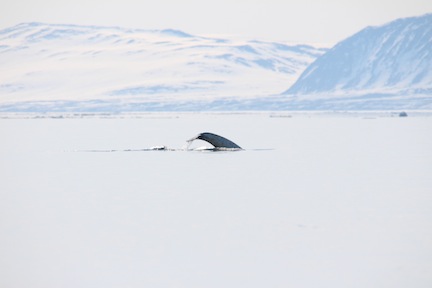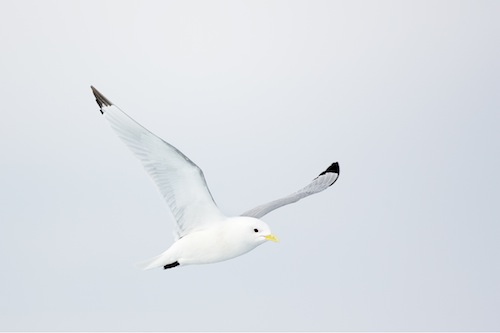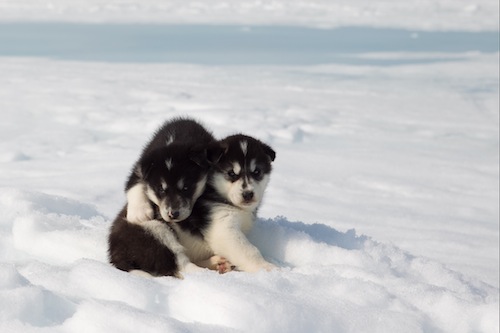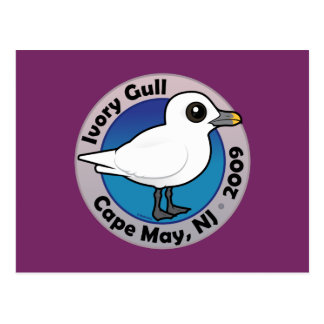Where We Are Today
On the Ice at the Edge of Baffin Bay
| As we scanned the calm sea, Jenny suddenly spotted a Narwhal. I ran back to the dining tent, opened the door, called “Narwhal”, and emptied the place. We all watched in awe as two Narwhals swam back and forth in front of our floe edge before diving and disappearing. We haven’t seen any tusks yet, but we have now definitely seen Narwhals. Ryan was able to get this sequence as one of them dove: |

|

|

|

|
|
Once Mark got the hydrophone set up, we could listen to the spiraling song of
Bearded Seals, a real wonder. (It was hard to believe such sounds came from a
mammal.) Now and then, the short moaning grunt of a Bowhead Whale could also be
heard.
This page
will let you listen to them both and is very much like what we heard. Of
course, what we were hoping to hear was Narwhals, but there seemed to be none
at all.
We spent the rest of the day at the floe edge but had no more Narwhal sightings. We saw many Ringed Seals, as well as Brant Geese, Canada Geese, Snow Geese, Common and King Eiders (great strings of them flying past), Long-tailed Ducks (ditto), Black-legged Kittiwakes, Long-tailed Jaegers/Skuas, a single Pomarine Jaeger/Skua (with its interestingly curled tail streamer), Glaucous Gulls, and Thick-billed Murres. |
 King Eider Cambridge Bay, Canada (Photo courtesy of John Chapman) |
 Black-legged Kittiwake (Photo courtesy of John Chapman) |
 Pomarine Jaeger (Photo courtesy of Jenny Varley) |
|
Emma, our biology teacher, is keen to learn to identify the birds we are seeing
and is a quick learner. I have been using the
Sibley app
on my iPhone to help her and am delighted with her progress. The high-tech
gloves I bought myself in Princeton on Monday have little plastic pads on the
fingertips that are supposed to enable one to use a touchscreen while wearing
them, but it doesn’t seem to work for me, so I must take my gloves off.
(I’ve considered trying to learn to use it with my nose, but that’s
probably not warm enough.)
I was impressed with how much time and gentleness Mark gave to helping the photographers in the group understand their cameras better and improve their photographic techniques. He is especially good with our young aspiring photographer Ryan. Lunch was excellent home-made tomato soup and grilled cheese sandwiches. We are really being spoiled. The afternoon continued to be stunningly beautiful and irresistible to the photographers among us, including me:. |
|
|
|
| The “best” bird of the day was an Ivory Gull. Ivory Gulls are one of three species of rare gulls who spend their entire lives in the High Arctic (though we had one in New Jersey a few winters ago, to the delight of thousands of birders). They are rather small and are the only all-white gull. The North American population is probably no more than 2500 and is falling rapidly, partly due to the concentration of PCBs and DDT in Arctic waters (which is also reducing the viability of marine mammals). Ivory Gulls make their living basically by scavenging on Polar Bear kills. The bird today was attracted to the camp by the food put out for our guard dog and her three puppies. (Our guard dog is guaranteed to bark if a Polar Bear comes within a kilometer of camp.) |
|
Ivory Gull (Photo courtesy of Ryan and Elaine) |
Ivory Gull (Photo courtesy of Ryan and Elaine) |
 Our guard dog (Photo courtesy of John Chapman) |
 Two of the puppies (Photo courtesy of John Chapman) |
| (The Ivory Gull that came to New Jersey in 2009, a first-winter bird, was declared Cape May’s Bird of the Decade. Indeed, Lee and I drove down there to see it twice, though we’d had somewhat distant views of four Ivory Gulls during our cruise on the Kapitan Khlebnikov. The excitement in Cape May was such that they even made up T-shirts and coffee mugs (and doggie T-shirts) in the gull’s honor. The gull was content to dine on fish purchased for it by birders and was remarkably tame. I suppose if you spend your life following Polar Bears around, humans don’t seem all that formidable. You can watch the Cape May Ivory Gull feeding on YouTube.) |

|
| As evening came, we could see that the pack ice, though distant, was moving closer. When I zoomed in on it, I noticed that a trick of the light had made the ice look blue, a very striking effect. |
|
|
|
|
By the time we went in to a rather late dinner, I was so tired (and probably so full of hot chocolate) that I had no appetite for the beautiful meal, which started with a raw caribou carpaccio. I was impressed that Ryan was adventurous enough at 13 to eat that, but it was clear that he was relieved when Katie brought him a grilled cheese sandwich. For the rest of us, a hot caribou appetizer came next and was followed by a beautiful steamed fish, with wild blueberries in cream for dessert. As we were chatting during dinner, Mark lamented the ongoing decline in British passerines, which will only get worse with the recent movements to open up more greenbelts to development. When we went back out to the floe edge after dinner, the scene had changed completely. The pack ice that had been drawing nearer during the afternoon was now close in front of us. In less than an hour it was right upon us. |
|
Floe edge and pack ice at 9:45 |
Floe edge and pack ice at 10:30 |
